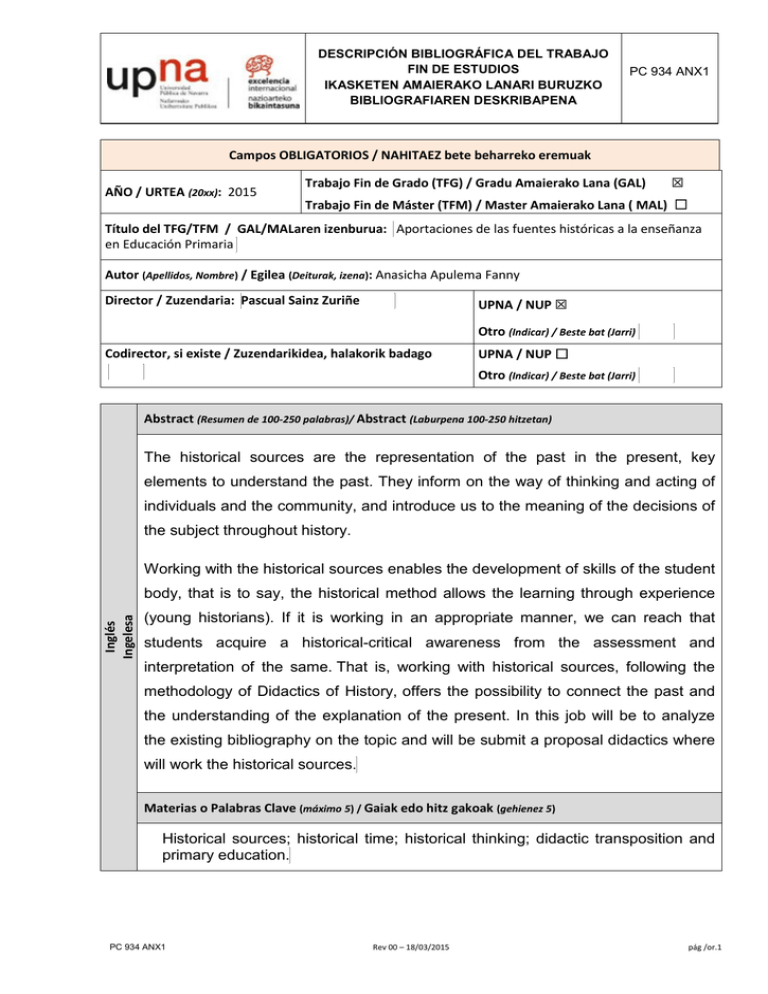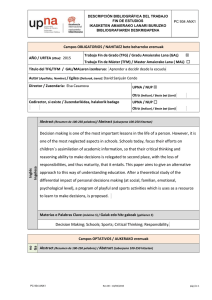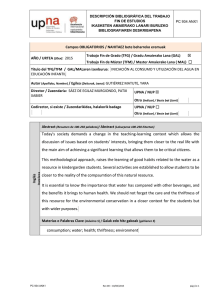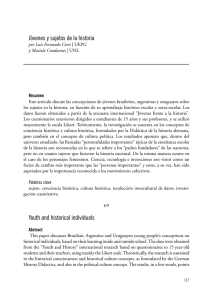The historical sources are the representation of the past in the
Anuncio

DESCRIPCIÓN BIBLIOGRÁFICA DEL TRABAJO FIN DE ESTUDIOS IKASKETEN AMAIERAKO LANARI BURUZKO BIBLIOGRAFIAREN DESKRIBAPENA PC 934 ANX1 Campos OBLIGATORIOS / NAHITAEZ bete beharreko eremuak AÑO / URTEA (20xx): 2015 Trabajo Fin de Grado (TFG) / Gradu Amaierako Lana (GAL) ☒ Trabajo Fin de Máster (TFM) / Master Amaierako Lana ( MAL) ☐ Título del TFG/TFM / GAL/MALaren izenburua: Aportaciones de las fuentes históricas a la enseñanza en Educación Primaria Autor (Apellidos, Nombre) / Egilea (Deiturak, izena): Anasicha Apulema Fanny Director / Zuzendaria: Pascual Sainz Zuriñe UPNA / NUP ☒ Otro (Indicar) / Beste bat (Jarri) Codirector, si existe / Zuzendarikidea, halakorik badago UPNA / NUP ☐ Otro (Indicar) / Beste bat (Jarri) Abstract (Resumen de 100-250 palabras)/ Abstract (Laburpena 100-250 hitzetan) The historical sources are the representation of the past in the present, key elements to understand the past. They inform on the way of thinking and acting of individuals and the community, and introduce us to the meaning of the decisions of the subject throughout history. Working with the historical sources enables the development of skills of the student Inglés Ingelesa body, that is to say, the historical method allows the learning through experience (young historians). If it is working in an appropriate manner, we can reach that students acquire a historical-critical awareness from the assessment and interpretation of the same. That is, working with historical sources, following the methodology of Didactics of History, offers the possibility to connect the past and the understanding of the explanation of the present. In this job will be to analyze the existing bibliography on the topic and will be submit a proposal didactics where will work the historical sources. Materias o Palabras Clave (máximo 5) / Gaiak edo hitz gakoak (gehienez 5) Historical sources; historical time; historical thinking; didactic transposition and primary education. PC 934 ANX1 Rev 00 – 18/03/2015 pág /or.1 DESCRIPCIÓN BIBLIOGRÁFICA DEL TRABAJO FIN DE ESTUDIOS IKASKETEN AMAIERAKO LANARI BURUZKO BIBLIOGRAFIAREN DESKRIBAPENA PC 934 ANX1 Campos OPTATIVOS / AUKERAKO eremuak Abstract (Resumen de 100-250 palabras) / Abstract (Laburpena 100-250 hitzetan) Las fuentes históricas son la representación del pasado en el presente, elementos clave para comprender el pasado. Informan sobre la forma de pensar y de actuar de los individuos y de la colectividad, y nos introducen en el significado de las decisiones de los sujetos a lo largo de la historia. Trabajar con las fuentes históricas permite el desarrollo de habilidades del Castellano Gaztelania alumnado, es decir, el método histórico permite el aprendizaje a través de la experiencia (pequeños historiadores). Si se trabaja de manera adecuada, se puede conseguir que el alumnado adquiera una conciencia histórica-crítica a partir de la valoración y de la interpretación de las mismas. Es decir, trabajar con fuentes históricas, siguiendo la metodología de la didáctica histórica, ofrece la posibilidad de conectar el pasado y la comprensión de la explicación del presente. En este trabajo se va a analizar la bibliografía existente sobre el tema y se presenta una propuesta didáctica donde se trabajan las fuentes históricas. Materias o Palabras Clave (máximo 5) / Gaiak edo hitz gakoak (gehienez 5) Fuentes históricas; tiempo histórico; pensamiento histórico; transposición didáctica y educación primaria. Euskera Euskara Abstract (Resumen de 100-250 palabras) / / Abstract (Laburpena 100-250 hitzetan) Materias o Palabras Clave (máximo 5) / Gaiak edo hitz gakoak (gehienez 5) Otro Idioma Beste hizk. bat Abstract (Resumen de 100-250 palabras) / / Abstract (Laburpena 100-250 hitzetan) Materias o Palabras Clave (máximo 5) / Gaiak edo hitz gakoak (gehienez 5) PC 934 ANX1 Rev 00 – 18/03/2015 pág /or.2


